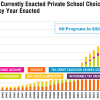Among the research I commended in the 2024 Economic Report of the President (ERP) last week was a solid section on free trade’s “pro‐poor bias,” i.e., that eliminating US government barriers to cross‐border commerce disproportionately benefited Americans with lower incomes. This week, the Federal Reserve Bank of Minneapolis highlights a brand new paper showing much the same thing (emphasis mine):
In a Minneapolis Fed staff report, Monetary Advisor Michael Waugh models how lower trade costs play out for richer and poorer households (Staff Report 653, “Heterogeneous Agent Trade”). Waugh finds starkly different effects, with poor households (defined by their level of consumer spending) gaining much more as freer trade lowers prices.
The reason is not that poorer households buy a larger proportion of imported goods. Rather, it is their higher marginal utility of consumption: Falling prices provide more value to households with tighter budgets, as evidenced by their sensitivity to prices. Low‐income households react more strongly as trade drives down the prices of imports and competing domestic goods. These households increase their consumption more as their buying power increases, and they are quicker to substitute new products in pursuit of savings.
Waugh finds that all US households benefit from a 10 percent reduction in US trade costs. But the poorest fifth of households experience a welfare gain more than 4.5 times larger than the richest.
Given the ample academic research cited in the ERP, these new findings, while welcome, are unsurprising. However, they do raise the following question related to the 2024 US presidential campaign: If an across‐the‐board 10 percent reduction in US trade costs generates outsized gains for America’s poor, what does an across‐the‐board 10 percent increase in those same costs—say, via the universal tariff proposed by Donald Trump—do?
For more on the benefits of free trade and the costs of protectionism, be sure to check out Cato’s ongoing Defending Globalization project or this 2022 Cato paper from me and Alfredo Carrillo Obregon.





















